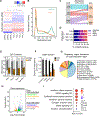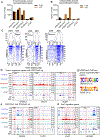Epigenome Reprogramming Through H3K27 and H3K4 Trimethylation as a Resistance Mechanism to DNA Methylation Inhibition in BRAFV600E-Mutated Colorectal Cancer
- PMID: 39269307
- PMCID: PMC11829253
- DOI: 10.1158/1078-0432.CCR-24-1166
Epigenome Reprogramming Through H3K27 and H3K4 Trimethylation as a Resistance Mechanism to DNA Methylation Inhibition in BRAFV600E-Mutated Colorectal Cancer
Abstract
Purpose: BRAFV600E-mutated colorectal cancer exhibits a strong correlation with DNA hypermethylation, suggesting that this subgroup of tumors presents unique epigenomic phenotypes. Nonetheless, 5-azacitidine, which inhibits DNA methyltransferase activity, is not efficacious in BRAFV600E colorectal cancer in vivo.
Experimental design: We randomized and treated mice implanted with patient-derived tumor xenografts harboring BRAFV600E mutation with control, 5-azacitidine, vemurafenib (BRAF inhibitor), or the combination. Comprehensive epigenomic profiling was conducted on control and 5-azacitidine-treated tumor samples, including DNA methylation, histone modifications, chromatin accessibility, and gene expression. Combinations of epigenetic agents were explored in preclinical BRAFV600E colorectal cancer models.
Results: A profound reduction of DNA methylation levels upon 5-azacitidine treatment was confirmed, however, transcriptional repression was not relieved. This study unbiasedly explored the adaptive engagement of other epigenomic modifications upon 5-azacitidine treatment. A loss of histone acetylation and a gain of histone methylations, including H3K27 and H3K4 trimethylation, were observed around these hypomethylated regions, suggesting the involvement of polycomb repressive complex (PRC) activity around the genome with loss of DNA methylation, therefore maintaining the repression of key tumor-suppressor genes. Combined inhibition of PRC activity through EZH2 inhibition with 5-azacitidine treatment additively improved efficacies in BRAFV600E colorectal cancer cells.
Conclusions: In conclusion, DNA hypomethylation by 5-azacitidine exhibits a close association with H3K27me3 and PRC activity in BRAFV600E colorectal cancer, and simultaneous blockade of DNA methyltransferase and EZH2 holds promise as a potential therapeutic strategy for patients with BRAFV600E-mutated colorectal cancer.
©2024 American Association for Cancer Research.
Figures





References
-
- Siegel RL, Giaquinto AN, Jemal A. Cancer statistics, 2024. CA Cancer J Clin. 2024;74(1):12–49. - PubMed
-
- Siegel RL, Wagle NS, Cercek A, Smith RA, Jemal A. Colorectal cancer statistics, 2023. CA Cancer J Clin. 2023;73(3):233–54. - PubMed
-
- Feinberg AP, Tycko B. The history of cancer epigenetics. Nat Rev Cancer. 2004;4(2):143–53. - PubMed
MeSH terms
Substances
Grants and funding
LinkOut - more resources
Full Text Sources
Medical
Molecular Biology Databases
Research Materials

